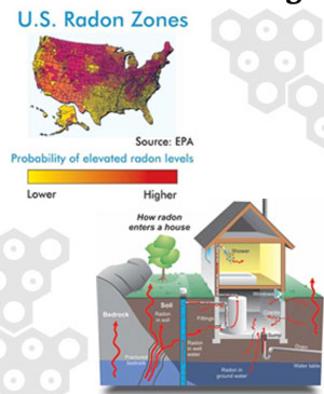Toll Free at 1-855-Dr Radon
Owner Operated Company
CALL TODAY FOR YOUR FREE PRICE QUOTE!!
UA-37881725-1
Radon R Us
You can't see radon. And you can't smell it or taste it. But it may be a problem in your home.
Radon is estimated to cause many thousands of deaths each year. That's because when you
breathe air containing radon, you can get lung cancer. In fact, the Surgeon General has warned
that radon is the second leading cause of lung cancer in the United States today. Only smoking
causes more lung cancer deaths. If you smoke and your home has high radon levels, your risk
of lung cancer is especially high.
Radon can be found all over the U.S.
Radon comes from the natural (radioactive) breakdown of uranium in soil, rock and water and
gets into the air you breathe. Radon can be found all over the U.S. It can get into any type of
building — homes, offices, and schools — and result in a high indoor radon level. But you and
your family are most likely to get your greatest exposure at home, where you spend most of
your time.
You should test for radon.
Testing is the only way to know if you and your family are at risk from radon. EPA and the
Surgeon General recommend testing all homes below the third floor for radon. EPA also
recommends testing in schools.
Testing is inexpensive and easy — it should only take a few minutes of your time. Millions of Americans
have already tested their homes for radon (see How to Test Your Home).
You can fix a radon problem.
Radon reduction systems work and they are not too costly. Some radon reduction systems can reduce radon levels in your home by up to 99%. Even very high levels can be reduced to acceptable levels.
New homes can be built with radon-resistant features.
Radon-resistant construction techniques can be effective in preventing radon entry. When installed properly and completely, these simple and inexpensive techniques can help reduce indoor radon levels in homes. In addition, installing them at the time of construction makes it easier and less expensive to reduce radon levels further if these passive techniques don't reduce radon levels to below 4 pCi/L. Every new home should be tested after occupancy, even if it was built radon-resistant. If radon levels are still in excess of 4 pCi/L, the passive system should be activated by having Radonrus mitigation install a vent fan. For more explanation of radon resistant construction techniques, refer to EPA publication, Building Radon Out: A Step-by-Step Guide on How to Build Radon-Resistant Homes.
How Does Radon Get Into Your Home?
Any home may have a radon problem
Radon is a radioactive gas. It comes from the natural decay of uranium that is found in nearly all soils. It typically moves up through the ground to the air above and into your home through cracks and other holes in the foundation. Your home traps radon inside, where it can build up. Any home may have a radon problem. This means new and old homes, well-sealed and drafty homes, and homes with or without basements.
Radon from soil gas is the main cause of radon problems. Sometimes radon enters the home through well water. In a small number of homes, the building materials can give off radon, too. However, building materials rarely cause radon problems by themselves.
RADON GETS IN THROUGH:
Cracks in solid floors
Construction joints
Cracks in walls
Gaps in suspended floors
Gaps around service pipes
Cavities inside walls
The water supply
Nearly 1 out of every 15 homes in the U.S. is estimated to have elevated radon levels. Elevated levels of radon gas have been found in homes in your state. Contact your state radon office for general information about radon in your area. While radon problems may be more common in some areas, any home may have a problem. The only way to know about your home is to test.
Radon can also be a problem in schools and workplaces. Ask your state radon office about radon problems in schools, daycare and childcare facilities, and workplaces in your area.
How to Test Your Home
You can't see radon, but it's not hard to find out if you have a radon problem in your home. All you need to do is test for radon. Testing is easy and should only take a few minutes of your time.
The amount of radon in the air is measured in "picocuries per liter of air," or "pCi/L." There are many kinds of low-cost "do-it-yourself" radon test kits you can get through the mail and in hardware stores and other retail outlets. If you prefer, or if you are buying or selling a home, you can hire a qualified tester to do the testing for you. You should first contact your state radon office about obtaining a list of qualified testers. You can also contact a private radon proficiency program for lists of privately certified radon professionals serving your area.
Call Michigan Department of Environment, Great Lakes, and Energy (EGLE) at 800-Radon Gas for additional information on certified radon testing technicians in your area. Please keep in mind it is a conflict of interest to have your home tested and mitigated by the same company.
Here is a link provided by EGLE, if you are interested in purchasing a DIY (Do-It-Yourself) Test Kit. Keep in mind this may not be acceptable for Real Estate Transactions. You should get the results within 2 weeks, from start to finish, after you receive it in the mail.
You can stop by or call your County Health Department for a Radon Test Kit
If you are interested in Constant Monitoring we recommend Airthings - Corentium or Wave. These and many more can be found at Amazon. See link below of radon monitoring systems:
FOR MORE INFORMATION PLEASE VISIT:
About Radon
Call Today 1-855 Dr Radon

